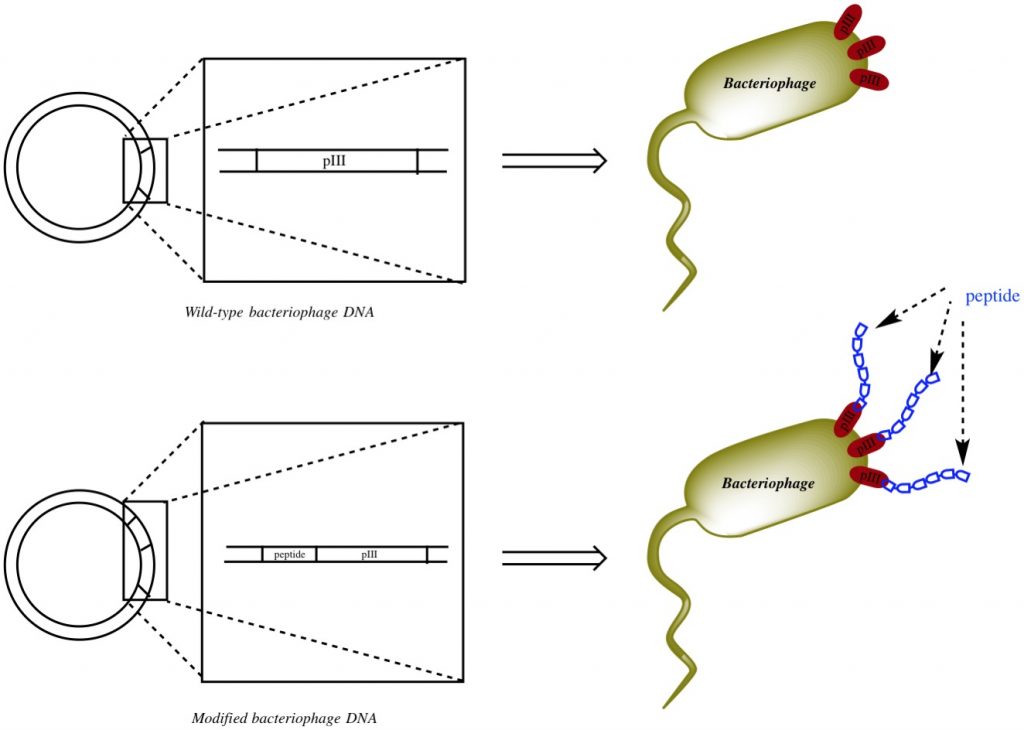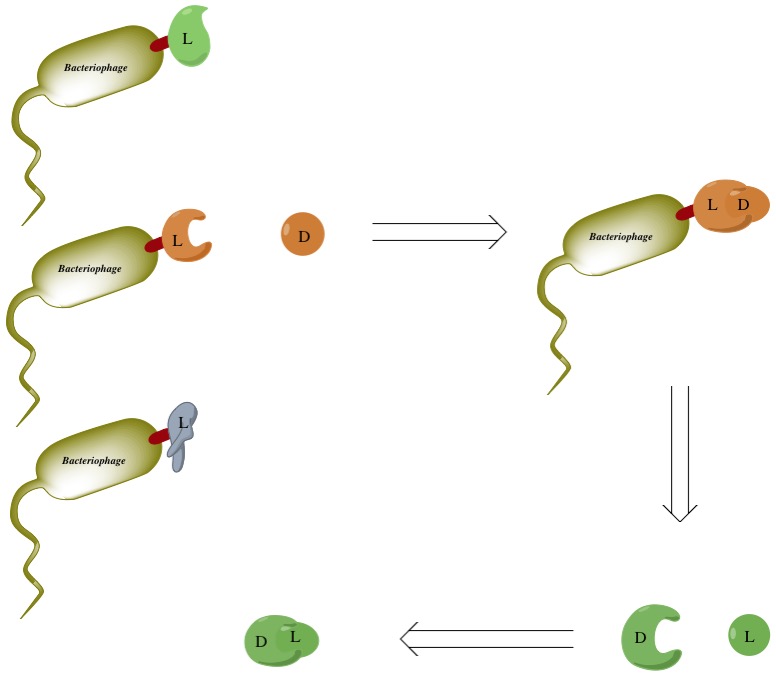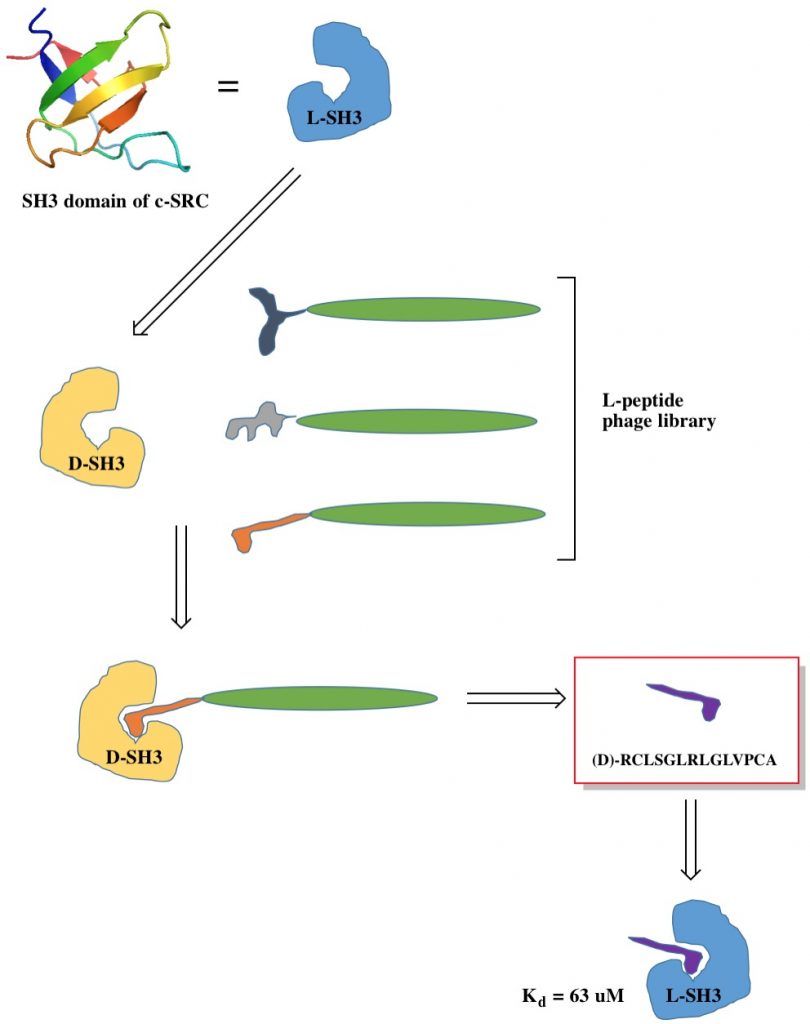Mirror-Image Phage Display
Mirror-image phage display is a technique used to identify viable D-peptides that bind naturally occurring domains. As a result, one practical use of the identified D-peptides is to target other protein domains in vivo, because D-peptides are resistant to proteolysis. This method involves screening a phage library of L-peptides with a target D-protein. The L-peptide ligands that bind to the D-protein are synthesized in their D-enantiomeric forms, which should bind to the naturally existing L-enantiomeric form of the target protein.
Phage Display
Phage display is a method of expressing proteins of interest on the surface of bacteriophages [26]. Bacteriophages naturally express a number of proteins on their capsid; one of the most commonly used ones for mirror-image phage display is the pIII protein. By splicing a gene that encodes the peptide of interest onto the N-terminus of the pIII gene, the peptide can be expressed outside the bacteriophage in it’s natural state. As a result, the pIII protein essentially anchors the peptide to the capsid. A great number of peptides are expressed on bacteriophages in this manner to create a phage display library.

Figure 1. Diagram of phage display. The pIII protein is one of many that is expressed on bacteriophage capsids. Splicing a sequence next to the pIII gene will anchor the peptide to the bacteriophage via the pIII protein.
The Generic Process
- Potential D-peptides are expressed in their L-enantiomeric forms on bacteriophage capsids. This creates a phage library of L -peptides [8].
- The D-enantiomeric form of the naturally occurring L-protein is synthesized. This is the target protein that the final D-peptide is designed to interfere/interact with.
- The phage library of L-peptides is screened for ligands that bind the target D-protein. Of interest are the L-peptides that bind the D-protein.
- D-enantiomeric forms of the successful L-peptide ligands are synthesized. These D-peptides should theoretically bind the L-enantiomeric form of the target protein, and be able to interact with it.

Figure 2. The steps of mirror-image phage display. A L-peptide phage library is screened against a target D-protein. The L-peptide ligand is synthesized in it’s D-enantiomeric form, which can bind to the natural L-protein.
Example: The SH3 domain
A great example of using mirror image phage display to identify a viable D-peptide is with the SH3 domain of the c-SRC protein [25]. The c-SRC protein has many functions and is related to osteoporosis, so targeting it could be a potential treatment. First, a 60-residue D-enantiomeric form of SH3 was synthesized as the target protein. Then a phage library of short 10-residue L-peptides was created and screened against the D-SH3 protein. The L-peptide ligand with the strongest affinity for D-SH3 was isolated, and the L-peptide was synthesized in it’s D-enantiomeric form with the following sequence: (D)-RCLSGLRLGLVPCA. This D-peptide was found to bind to the naturally occurring L-SHR with a Kd of 63 uM. This is a relatively strong affinity, which suggests that the D-peptide could potentially be an inhibitor of c-SRC.

Figure 3. Identification of D-peptide for SH3 domain. D-SH3 is synthesized and screened against a L-peptide phage library. The sequence of the strongest ligand is identified, and it’s D-enantiomeric form has a strong affinity for the natural L-SH3 (PDB: 5ECA [5]).
Applications of mirror-image phage display
The versatility and resilience of D-peptides open the door for many therapeutic possibilities. Many are currently being investigated for treatment of Alzheimer’s disease, AIDS, malaria, and other diseases [9]. One of the first therapeutic applications of D-peptides was to inhibit HIV entry into cells. A number of D-peptides were designed to mimic the HIV-1 binding pocket, and were extremely successful in inhibiting HIV infection. Later, a consensus sequence for the D-peptides was discovered and they were greatly optimized, resulting in approximately a 4 million fold improved binding efficiency [10]. D-peptides were also synthesized to bind to the Alzheimer’s amyloid-β peptide (Aβ). In this case, the D-peptides were not used to inhibit anything but rather to stain the Aβ peptides, so they could be visualized. Using fluorescent D-peptides, it was possible to see where the Aβ peptides were aggregating in the brain [9]. Another use for D-peptides is MDM2 inhibition. MDM2 deactivates the p53 tumor suppressor; therefore, MDM2 plays a role in tumor proliferation. D-peptides have been designed to bind to MDM2 using mirror-image phage display [25, 26].

November 12, 2016 at 1:44 am
This is a really interesting method! One way to improve the presentation of this method would be to example it through a paper/experiment that utilized this method. The figures you created were great supplements in understanding this method as well. I like the applications section because it grounds the reader in the importance of this technique. To increase the depth of this method, it would be helpful to include the process by which “splicing the peptide into the gene” is done. Including this information can aid in the creation of a more comprehensive method section.
November 12, 2016 at 1:51 am
Ignore my comment on grounding this method with a paper because I realized that your next section does just this. Maybe you can hyperlink that page to this page as well and include a brief sentence stating how this paper uses mirror-image phage display.
November 16, 2016 at 10:14 pm
This method is really interesting and overall very well-explained. Sometimes I get a little confused about when you are talking about ligands or the proteins they bind to. If you could be a little clearer about that language it would be helpful.
I’m assuming you didn’t make the first picture, so you should probably cite it in the caption. If you did make it, great graphic design skills!
November 17, 2016 at 11:18 am
How are the peptides bound to the phage capsids actually measured? The detection of protein binding can be done via several methods; I’m just curious to see which one they did here, considering that it would be too small to be observed using a microscope. Also, I think it would be interesting if you went over the specifics of how a library of peptides is created. Was error prone PCR used to amplify clones of the same gene? Not essential to the page, but if you want to add something more, that would be it.
July 31, 2023 at 4:25 pm
nyclueuc http://para-mayores.es/# nkwjoxpa
August 5, 2023 at 6:03 pm
accutane purchase https://isotretinoinacne.shop/# buy isotretinoin pill
August 14, 2023 at 10:11 am
waka ninomiya wrestling yue bwp catfight shibuya kaho boxing
August 19, 2023 at 12:23 am
cialis with daproxene tadalafilise.cyou/#
August 21, 2023 at 5:09 am
20 mg tadalafil tablets tadalafilise.cyou/#
August 22, 2023 at 10:14 am
cialis in italia what is cialis achat cialis en france
August 23, 2023 at 11:57 pm
cialis 50mg tadalafil tadalafil 5 mg precio cialis erection
August 25, 2023 at 11:34 pm
afib and ed meds cialis one a day cost recommended cialis dosage
August 27, 2023 at 6:24 pm
what is the price of cialis 20mg what is cialis 20mg used for cialis tadalafil generic